Subscribe to P2P-economy
Stay up to date! Get all the latest & greatest posts delivered straight to your inbox
Subscribe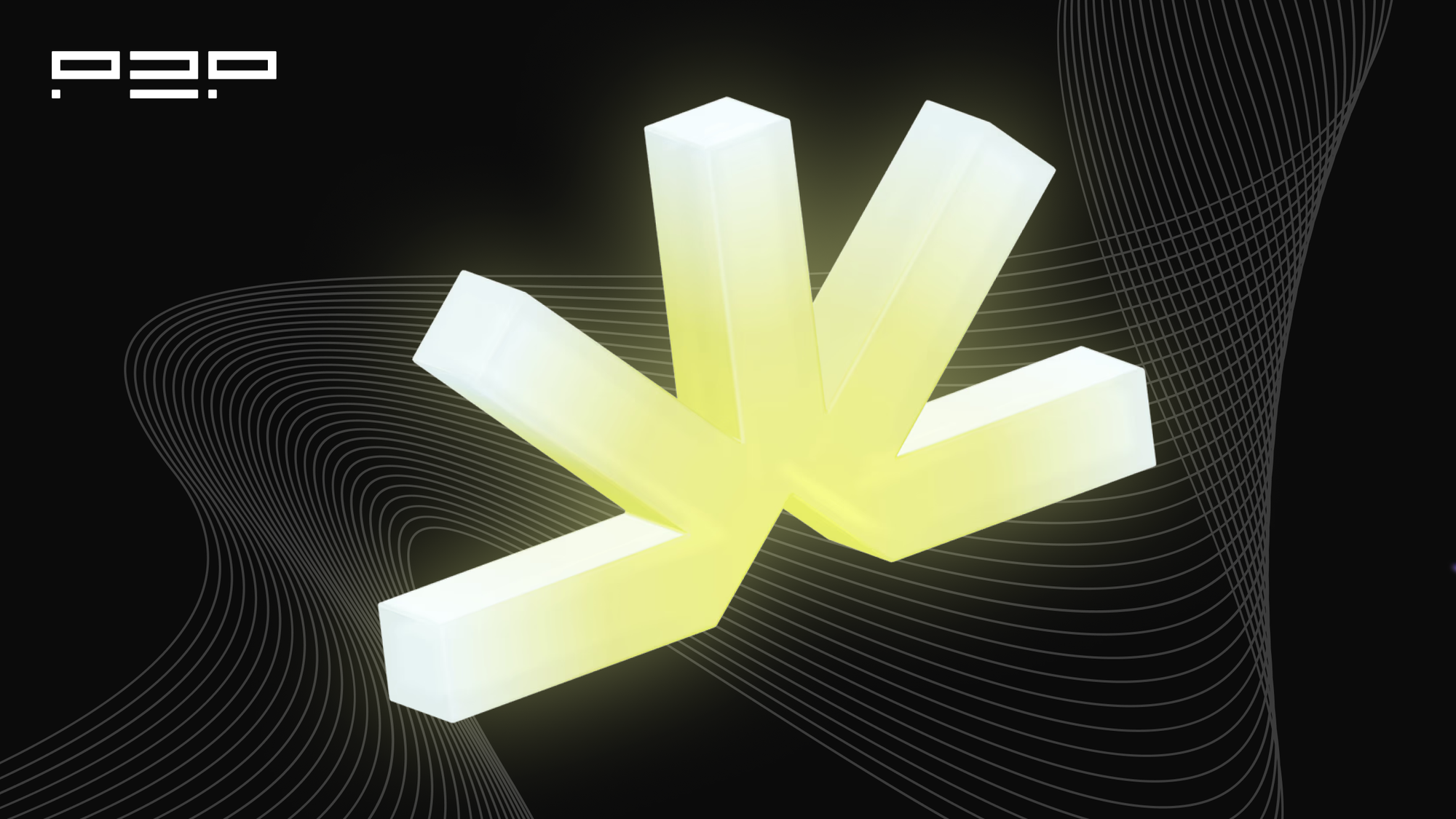
At P2P.org, we champion blockchain projects driving innovation, and Sahara AI’s blend of AI and blockchain is one of the most exciting we’ve seen. By bringing transparency, ownership, and fairness to the heart of AI development, Sahara AI is laying the foundation for a decentralized AI future.
As a validator in the SIWA testnet, we’re helping build an ecosystem empowering developers, creators — and most importantly, regular users — in their transition to an AI-powered future.
In this post, we’ll explore Sahara AI’s bold vision, its product suite, technical breakthroughs, testnet progress, and what’s coming next. We also break down where P2P.org fits in and why we’re fired up to be part of it.
Centralized AI systems, controlled by tech giants, limit access to data and computing resources, obscure data origins, and restrict fair rewards for contributors. Developers struggle to verify datasets, while users question AI reliability due to unclear processes. Sahara AI plans to tackle these, enabling transparent, accessible AI development for its community.
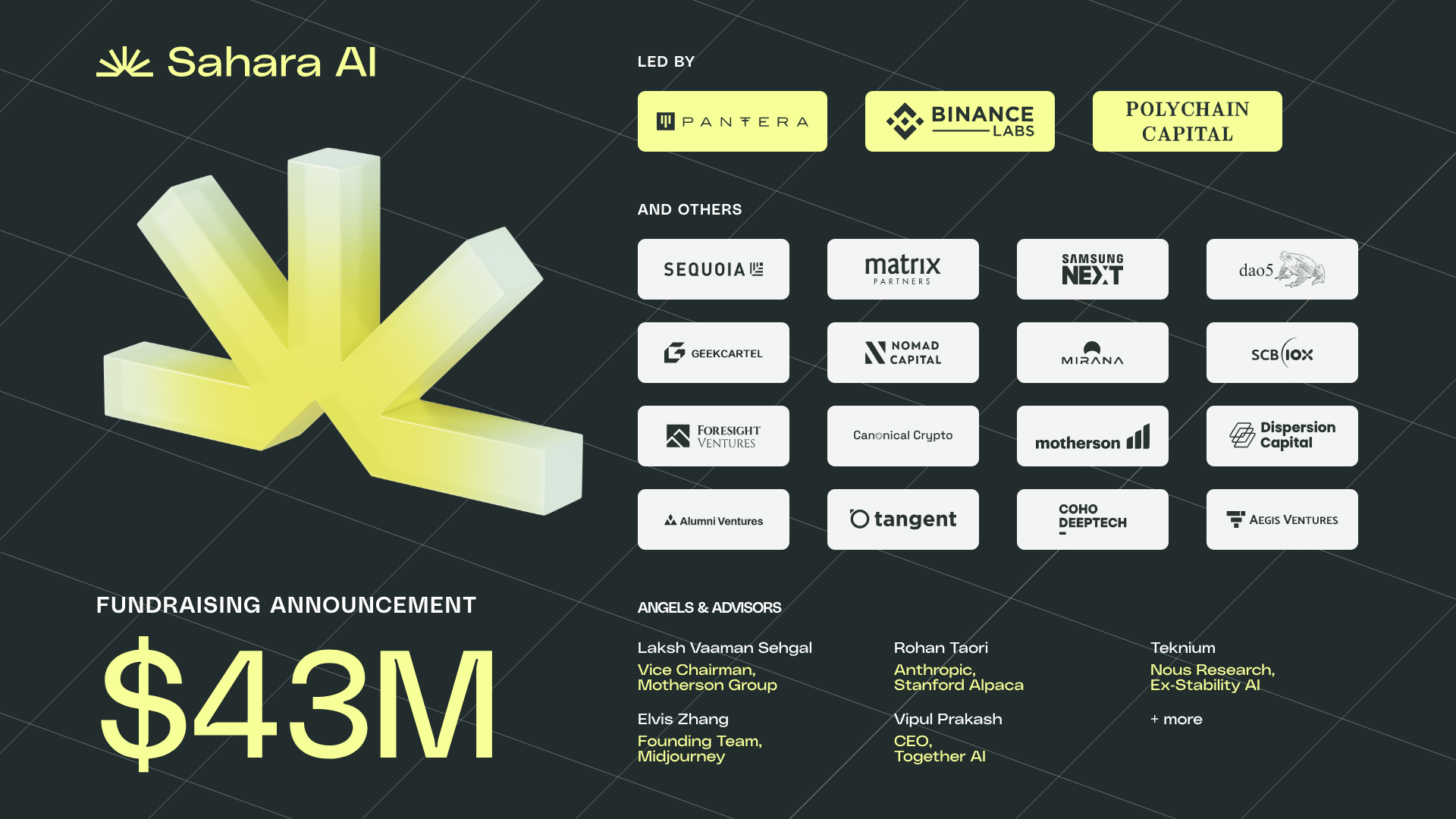
Sahara AI is already making serious waves. In August 2024, the company secured a massive $43 million funding round, led by heavyweights like Pantera Capital, YZi Labs (formerly Binance Labs), and Polychain Capital — with strategic backing from Samsung NEXT and Matrix Partners. This bold investment underscores surging confidence in Sahara AI’s decentralized AI vision. With industry veterans Sean Ren and Tyler Zhou (formerly of Binance Labs) at the helm, Sahara Labs is scaling up its global team, supercharging platform performance, and energizing its developer ecosystem. The goal? To democratize access to powerful AI tools and unlock new, secure ways for users around the world to monetize their AI assets.
Sahara AI is building the backbone for decentralized intelligence. Leveraging the Cosmos SDK for high-speed, low-cost transactions and full Ethereum Virtual Machine (EVM) compatibility for smart contract flexibility, the Sahara Blockchain was purpose-built with AI development in mind. It supports the full lifecycle of AI development by giving contributors and developers the infrastructure needed to register their AI assets, establish attribution, and enable transparent usage tracking across the ecosystem, no matter what chain they’re on. This creates the foundation for new models of monetization, licensing, and collaboration.

Sahara AI is building a powerful suite of products to democratize AI development, ensuring secure, transparent, and equitable access for everyone. In this publication we’ll focus on the Application Layer in particular.
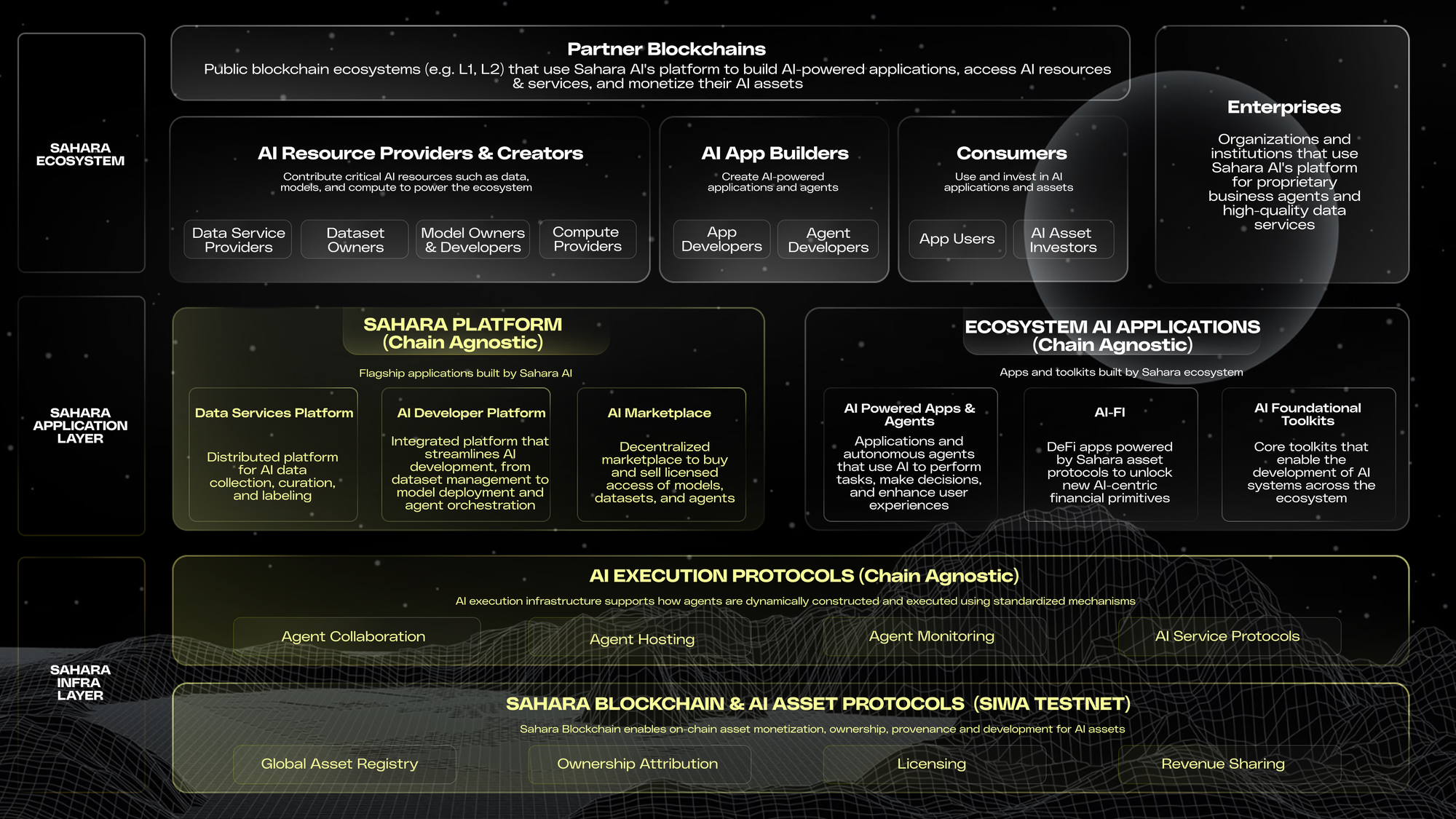
Together, these products form the foundation of Sahara AI’s Application Layer. They empower users and developers alike to contribute, innovate, and earn within a secure, equitable, and decentralized AI economy.
Following the success of the private testnet, which saw over 1.4 million daily active accounts and 200,000+ users on the Data Services Platform, Sahara AI has launched SIWA, its first public testnet. SIWA represents a major milestone: bringing AI ownership and provenance fully on-chain, and taking a critical step toward a fairer, decentralized AI economy.

SIWA already empowers participants to register and tokenize datasets, models, and AI assets as cryptographic proof of ownership, laying the groundwork for future licensing, attribution, and revenue sharing. This stage is extremely important for collecting feedback, refining details, and testing all aspects of the system to ensure a tamper-proof mainnet implementation.
P2P.org plays a key role as a validator on the SIWA testnet, helping to secure the network and maintain its integrity. Validators like P2P.org ensure that transactions are processed accurately, that asset provenance remains tamper-proof, and that the system performs reliably at scale. Community participation is equally essential, as it helps surface potential issues and ensure robust performance. These early efforts are vital to shaping a secure and decentralized foundation for the Sahara AI Blockchain on the mainnet.
SIWA Phase 1 is just the beginning. While it introduces foundational dataset registration and ownership, Sahara AI’s full protocol rollout will unlock deeper capabilities across licensing, monetization, and open-source development — paving the way for a fully decentralized AI stack.
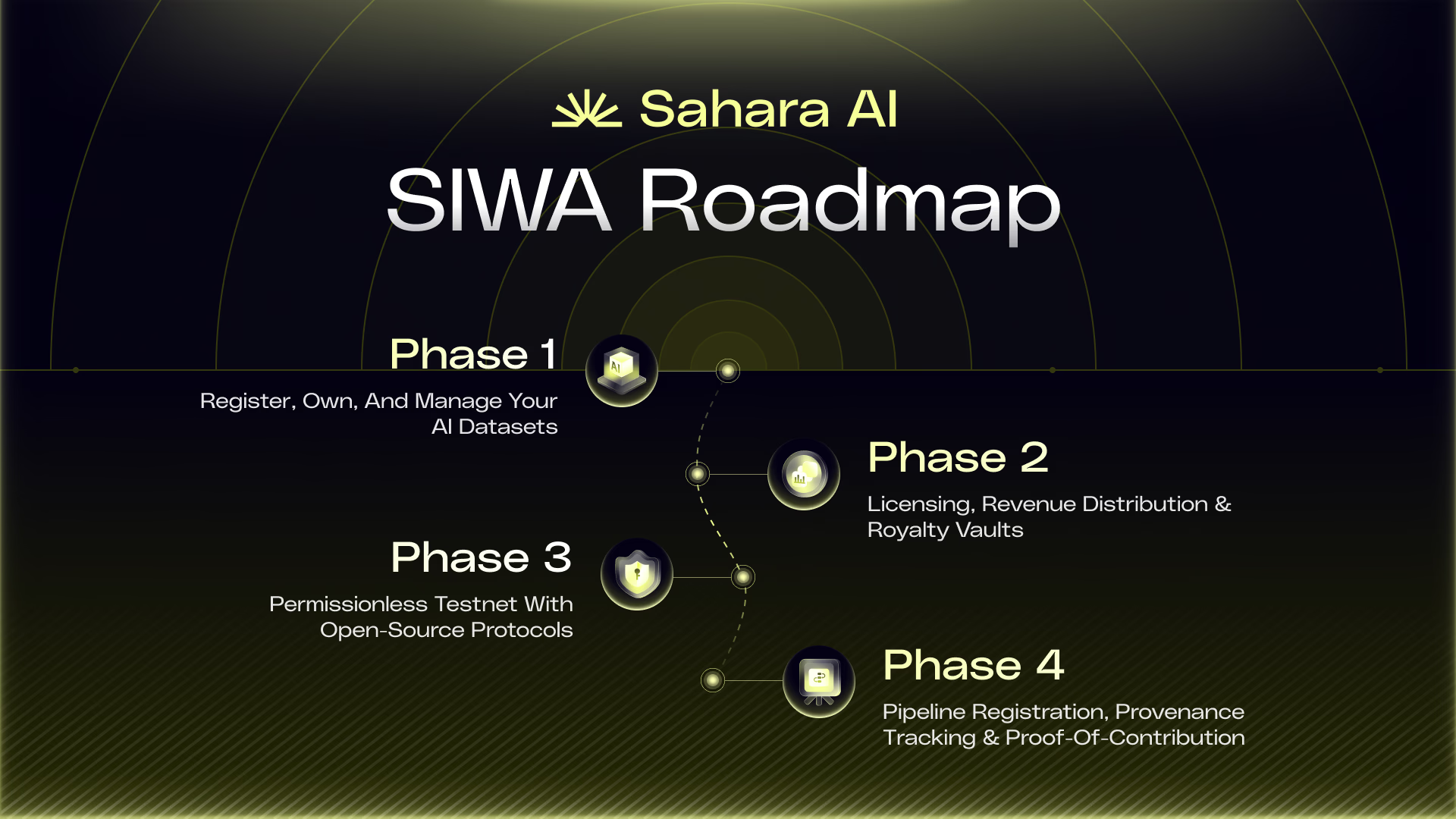
Phase 2 will bring licensing and revenue sharing on-chain, allowing developers to set custom licensing terms and automatically receive payments when their assets are used. With royalty vaults, asset owners and investors will claim proportional revenue based on usage, turning attribution into sustainable economic participation for all contributors.
This phase will fully decentralize the core infrastructure, eliminating reliance on a centralized multisig and enabling global, permissionless interaction with Sahara Protocols. An open-source ecosystem will allow developers to extend and integrate these protocols freely.
The final phase before mainnet will tokenize AI pipelines, providing on-chain registration and attribution for every workflow element. Contributors will earn tokens reflecting their relative value across datasets, models, and prompts, with automated revenue-sharing that recognizes and rewards every part of the AI value chain.
In a world where AI is growing at breakneck speed, Sahara AI stands out by putting real ownership and transparency at the center of development. While others focus only on technology, Sahara AI ensures data contributors and developers are recognized, compensated, and empowered within a truly decentralized ecosystem.
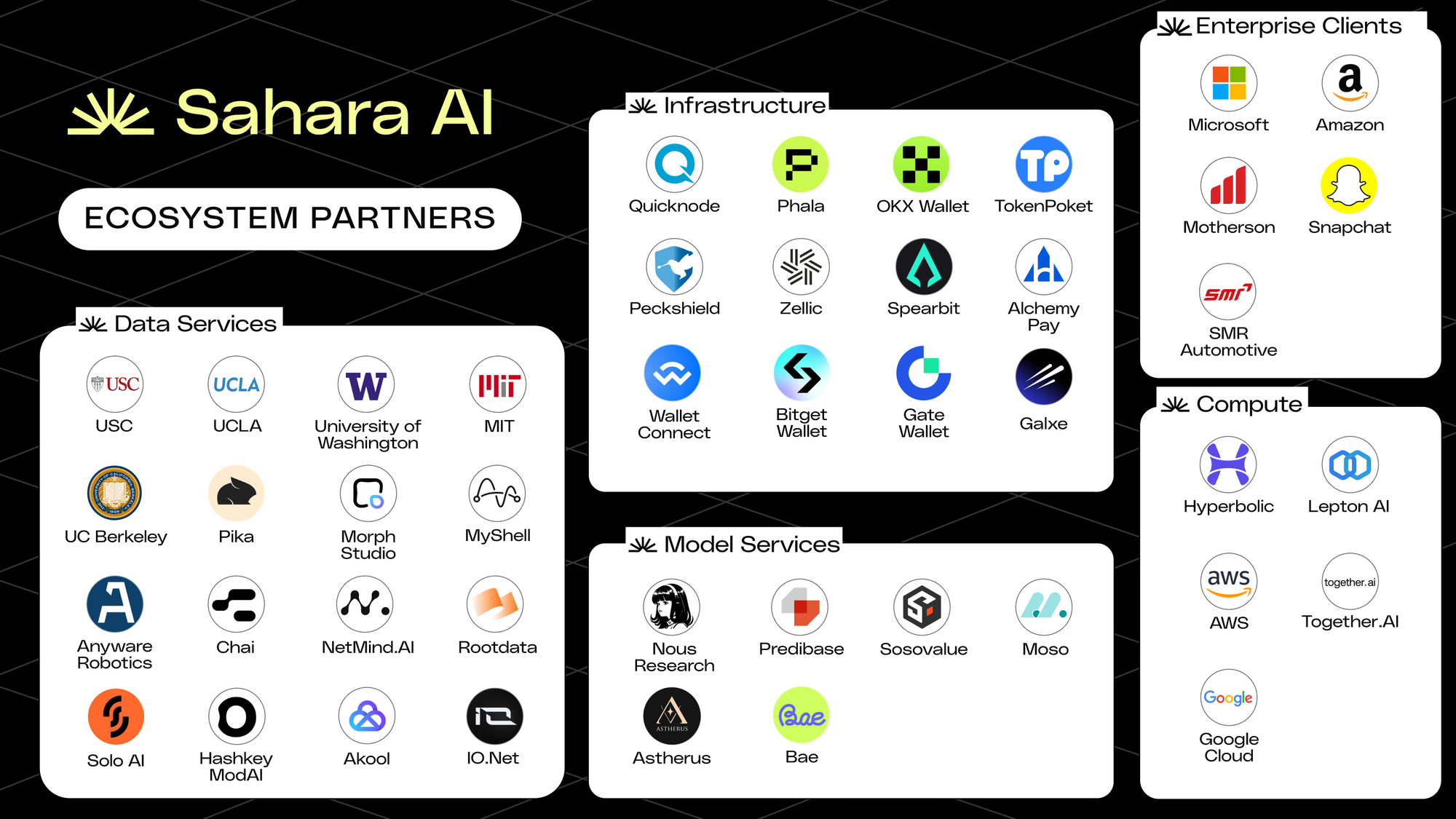
Its fast-paced progress, backed by a well-funded team, and the support of leading industry players and AI investors, demonstrates a commitment to solving real challenges like data verification and equitable access. Beyond technical innovation, Sahara AI cultivates a vibrant community that actively shapes and refines its protocols.
The momentum is building. Developers, businesses, and creators are already tapping into Sahara’s tools to power new AI applications, unlock revenue streams, and build a more inclusive future for machine intelligence. With trusted validators like P2P.org securing the network, Sahara AI isn’t just a blockchain or a platform — it’s a movement redefining how AI is built, owned, and shared in the Web3 era.
The Sahara AI ecosystem is live and evolving, offering opportunities for developers, data contributors, and creators to help shape the future of AI.
Join the conversation and stay updated through Sahara AI’s blog, Discord, and X channels. You can also join the SIWA public testnet to register your datasets, test how staking works, and contribute to building a decentralized and equitable AI economy.
<p></p><h2 id="tldr"><strong>TL;DR</strong></h2><ul><li>P2P.org is now available as a Solana validator on Fireblocks, enabling institutional clients to access industry-leading 9.40% total gross rewards without leaving their secure environment.</li><li>This integration delivers a triple-stream reward structure combining standard SOL staking, enhanced MEV, and monthly block rewards—all with zero technical complexity.</li><li>Fireblocks users can start staking within seconds through a streamlined interface, backed by P2P.org's expertise in managing over $10B across 40+ networks.</li></ul><p>We’re thrilled to announce a major achievement for institutional staking: P2P.org is now officially available as a Solana validator on Fireblocks—the industry's leading digital asset infrastructure platform trusted by over 2,000 institutions worldwide. This integration represents months of work and positions P2P.org at the forefront of institutional Solana staking.</p><p>Finally, Fireblocks clients gain access to <a href="http://p2p.org/?ref=p2p.org"><u>P2P.org</u></a>’s market-leading Solana rewards, enabling institutions to receive<strong> Solana Rewards</strong>.</p><h2 id="solana-rewards"><strong>Solana Rewards</strong></h2><p>By staking with <a href="http://p2p.org/?ref=p2p.org"><u>P2P.org</u></a> through Fireblocks, users now finally get direct access to our<strong> reward ecosystem</strong>. This multi-layered reward structure maximizes network reward potential through three distinct revenue streams:</p><ul><li><strong>SOL Staking Rewards</strong> - Automatically compounded every two days to maximize growth</li><li><strong>MEV Rewards</strong> - Enhanced through our proprietary MEV optimization strategies</li><li><strong>Block Rewards</strong> - Transaction fee sharing distributed monthly</li></ul><p>This comprehensive market-leading approach <strong>captures value from every aspect of Solana's reward structure</strong>, delivering a substantial advantage to Fireblocks clients over standard validation services. All of this is achieved while maintaining the institutional level of security and compliance framework that institutions require.</p><figure class="kg-card kg-image-card"><img src="https://p2p.org/economy/content/images/2025/06/image.png" class="kg-image" alt="" loading="lazy" width="2000" height="1125" srcset="https://p2p.org/economy/content/images/size/w600/2025/06/image.png 600w, https://p2p.org/economy/content/images/size/w1000/2025/06/image.png 1000w, https://p2p.org/economy/content/images/size/w1600/2025/06/image.png 1600w, https://p2p.org/economy/content/images/size/w2400/2025/06/image.png 2400w" sizes="(min-width: 720px) 720px"></figure><figure class="kg-card kg-image-card"><img src="https://lh7-rt.googleusercontent.com/docsz/AD_4nXfjuSzqz8G74OVsGEMd9mvFjbUzlLti71iT0u9aTsF42DPDhqUpoiKqsNs_phg_n3XSV6rwdl_vyVUDb5395U2lokcf8wORzxphjKO09Q2jl-wkTZVJ4t0pmTUa4x9-YkszwFApuQ?key=nGwrnZGkHUhe1fB3t48EAw" class="kg-image" alt="" loading="lazy" width="1600" height="1084"></figure><p>As part of Fireblocks' strategic expansion of staking capabilities, the platform has integrated P2P.org, giving its clients direct access to one of the highest-performing Solana validators. This integration delivers immediate benefits:</p><p><strong>Superior Rewards, Zero Complexity</strong>: Fireblocks users can now access P2P.org's industry-leading 9.40% total gross rewards, outperforming the network average of 9.16%—without ever leaving their secure Fireblocks environment.</p><p><strong>Institutional-Grade Infrastructure</strong>: Stake with confidence knowing your assets are backed by P2P.org's enterprise validation technology and Fireblocks' unparalleled security architecture.</p><p><strong>Streamlined Experience</strong>: Fireblocks' enhanced validator selection interface makes it simple to compare providers and make informed staking decisions in just a few clicks.</p><h2 id="why-it-matters"><strong>Why It Matters</strong></h2><h3 id="first-mover-advantage"><strong>First-Mover Advantage</strong></h3><p>As one of the first validators available for Solana on Fireblocks, P2P.org gives institutions immediate access to elite staking infrastructure without the traditional technical barriers. Our solution combines years of validator expertise, enterprise-grade performance, and the credibility of managing $10B+ across 40+ networks—delivering a significant competitive edge to early adopters in the institutional Solana ecosystem.</p><h3 id="market-leading-performance"><strong>Market Leading Performance</strong></h3><p>Our advanced validator technology maximizes blockspace efficiency that delivers a measurable financial impact:</p><ul><li><strong>Among the highest Solana stake under management globally</strong></li><li><strong>99.9% block production history</strong></li><li><strong>Built-in MEV rewards </strong> without requiring opt-in</li><li><strong>Higher annualized rewards</strong> (9.40% vs. 9.16% network average)</li><li><strong>Compound growth advantage</strong> that widens over time</li></ul><h3 id="risk-management-through-integration"><strong>Risk Management Through Integration</strong></h3><p>This integration enables institutions to select preferred validators without sacrificing security, compliance, or rewards, allowing for strategic portfolio diversification and reduced exposure to single-provider risks. The addition of further staking providers on Solana also contributes to decentralization and Solana network resilience. </p><h2 id="getting-started-takes-seconds"><strong>Getting Started Takes Seconds</strong></h2><ol><li>Navigate to your Fireblocks staking dashboard and select Solana.</li><li>You’ll now see P2P.org listed as a staking provider.</li><li>Select P2P.org, review and accept the terms, and initiate staking.</li><li>For API-based workflows, use the Fireblocks API with our provider ID<br></li></ol><p>If you’re looking for special offers, please reach out to your personal Fireblocks account manager.</p><p>Comprehensive documentation is available through<a href="https://www.fireblocks.com/partners/?_gl=1*z5h1p8*_up*MQ..*_gs*MQ..&gclid=CjwKCAjw87XBBhBIEiwAxP3_Ay8eSxnWHHj5TA5FdtQJCp6_HtA0Aqqcpt4JqcGkw-2__poTEkPL7BoCrfwQAvD_BwE&gbraid=0AAAAAorYxp8XgphJmjdscfNxOvFOMQF3T&ref=p2p.org"><u> Fireblocks Staking Partners documentation</u></a>.</p><figure class="kg-card kg-video-card kg-width-regular" data-kg-thumbnail="https://p2p.org/economy/content/media/2025/06/Fireblocks-video_thumb.jpg" data-kg-custom-thumbnail=""> <div class="kg-video-container"> <video src="https://p2p.org/economy/content/media/2025/06/Fireblocks-video.mp4" poster="https://img.spacergif.org/v1/3040x1650/0a/spacer.png" width="3040" height="1650" loop="" autoplay="" muted="" playsinline="" preload="metadata" style="background: transparent url('https://p2p.org/economy/content/media/2025/06/Fireblocks-video_thumb.jpg') 50% 50% / cover no-repeat;"></video> <div class="kg-video-overlay"> <button class="kg-video-large-play-icon" aria-label="Play video"> <svg xmlns="http://www.w3.org/2000/svg" viewBox="0 0 24 24"> <path d="M23.14 10.608 2.253.164A1.559 1.559 0 0 0 0 1.557v20.887a1.558 1.558 0 0 0 2.253 1.392L23.14 13.393a1.557 1.557 0 0 0 0-2.785Z"></path> </svg> </button> </div> <div class="kg-video-player-container kg-video-hide"> <div class="kg-video-player"> <button class="kg-video-play-icon" aria-label="Play video"> <svg xmlns="http://www.w3.org/2000/svg" viewBox="0 0 24 24"> <path d="M23.14 10.608 2.253.164A1.559 1.559 0 0 0 0 1.557v20.887a1.558 1.558 0 0 0 2.253 1.392L23.14 13.393a1.557 1.557 0 0 0 0-2.785Z"></path> </svg> </button> <button class="kg-video-pause-icon kg-video-hide" aria-label="Pause video"> <svg xmlns="http://www.w3.org/2000/svg" viewBox="0 0 24 24"> <rect x="3" y="1" width="7" height="22" rx="1.5" ry="1.5"></rect> <rect x="14" y="1" width="7" height="22" rx="1.5" ry="1.5"></rect> </svg> </button> <span class="kg-video-current-time">0:00</span> <div class="kg-video-time"> /<span class="kg-video-duration">0:25</span> </div> <input type="range" class="kg-video-seek-slider" max="100" value="0"> <button class="kg-video-playback-rate" aria-label="Adjust playback speed">1×</button> <button class="kg-video-unmute-icon" aria-label="Unmute"> <svg xmlns="http://www.w3.org/2000/svg" viewBox="0 0 24 24"> <path d="M15.189 2.021a9.728 9.728 0 0 0-7.924 4.85.249.249 0 0 1-.221.133H5.25a3 3 0 0 0-3 3v2a3 3 0 0 0 3 3h1.794a.249.249 0 0 1 .221.133 9.73 9.73 0 0 0 7.924 4.85h.06a1 1 0 0 0 1-1V3.02a1 1 0 0 0-1.06-.998Z"></path> </svg> </button> <button class="kg-video-mute-icon kg-video-hide" aria-label="Mute"> <svg xmlns="http://www.w3.org/2000/svg" viewBox="0 0 24 24"> <path d="M16.177 4.3a.248.248 0 0 0 .073-.176v-1.1a1 1 0 0 0-1.061-1 9.728 9.728 0 0 0-7.924 4.85.249.249 0 0 1-.221.133H5.25a3 3 0 0 0-3 3v2a3 3 0 0 0 3 3h.114a.251.251 0 0 0 .177-.073ZM23.707 1.706A1 1 0 0 0 22.293.292l-22 22a1 1 0 0 0 0 1.414l.009.009a1 1 0 0 0 1.405-.009l6.63-6.631A.251.251 0 0 1 8.515 17a.245.245 0 0 1 .177.075 10.081 10.081 0 0 0 6.5 2.92 1 1 0 0 0 1.061-1V9.266a.247.247 0 0 1 .073-.176Z"></path> </svg> </button> <input type="range" class="kg-video-volume-slider" max="100" value="100"> </div> </div> </div> </figure><h2 id="looking-ahead"><strong>Looking Ahead</strong></h2><p>While Fireblocks plans to expand its validator roster over time, P2P.org is fully integrated and available today. We're committed to building more seamless integration points that make institutional staking accessible, secure, and profitable across all major networks.</p><p>Ready to experience institutional-grade Solana staking? Visit <a href="http://p2p.org/solana?ref=p2p.org"><u>p2p.org/solana</u></a> or <a href="mailto:[email protected]"><u>get in touch directly with us here</u></a>.</p>
from p2p validator
<p></p><h3 id="tldr"><strong>TL;DR</strong></h3><ul><li><strong>Validator infra isn’t “set and forget.”</strong> Small missteps like missed attestations or key mismanagement can quietly erode rewards or lead to slashing.</li><li><strong>Institutional staking demands more than uptime.</strong> It requires security, chain-specific tuning, real-time monitoring, and reporting that actually informs action.</li><li><strong>P2P.org takes the technical risk off the table.</strong> We build high-performance, secure, and scalable validator infrastructure that helps institutions stake smarter and safer.</li></ul><h2 id="why-validator-infrastructure-breaks"><strong>Why Validator Infrastructure Breaks</strong></h2><p>Validator infrastructure is often treated like a set-and-forget service. But in reality, it’s one of the most failure-prone layers in a staking operation, especially at institutional scale. Missed rewards, security breaches, slashing events, and opaque reporting can turn staking from a revenue source into a liability.</p><p>Instead, think of validating the as engine room of proof-of-stake networks. There are a lot of moving parts, and these precise components must work in harmony for long-term reliability. </p><p>At P2P.org, we're trusted with over $10 billion in delegated assets from 90,000+ delegators. Through that, we’ve seen what breaks, what scales, and what separates top-tier validators from everyone else. In this article, we’ll walk through eight of the most common technical pitfalls we see, and how we help institutions avoid them.</p><p></p><h3 id="1-missed-attestations-cut-into-returns"><strong>1. Missed Attestations Cut into Returns</strong></h3><p>Attestations are how validators prove they’re doing their job. On Ethereum and other networks, timing matters. If your infrastructure can’t keep up, even small delays can result in skipped rewards.</p><p>This kind of underperformance usually isn’t obvious until it starts impacting the bottom line. It becomes more noticeable during periods of network congestion or when running multiple validators under load.<br><br><strong>The solution?</strong> Infrastructure needs to be fast, resilient, and able to handle peak demand without lag.</p><p><strong>How P2P.org handles it</strong><br>We deploy regionally distributed infrastructure with built-in load balancing and failover capacity. Our systems are tuned for low-latency response across networks, so our clients get more consistent results.</p><p></p><h3 id="2-slashing-events-from-double-signing"><strong>2. Slashing Events from Double Signing</strong></h3><p>If a validator signs two conflicting messages on the same network, it can get penalized or ejected. This often happens when infrastructure is misconfigured or improperly backed up.</p><p>We’ve seen this impact operators who were running high volumes of validators without clear separation between active and backup nodes.</p><p><strong>The solution?</strong> There must be strict controls to ensure only one active validator signs at a time — no exceptions.</p><p><strong>How P2P.org handles it</strong><br>We separate key roles, implement strict failover logic, and configure validators with chain-specific slashing protections. All this is designed to prevent double-signing before it ever becomes a risk.</p><p></p><h3 id="3-poor-monitoring-delays-fixes"><strong>3. Poor Monitoring Delays Fixes</strong></h3><p>Issues don’t always come from downtime. They can creep in through latency, network desync, or validator drift. Without the right alerting in place, these problems can go unnoticed until it’s too late.</p><p>In the past year, we’ve seen network upgrades cause unanticipated sync issues that left many operators scrambling.</p><p><strong>The solution? </strong>Proactive, real-time monitoring is essential to catch problems early and act before rewards are lost.</p><p><strong>How P2P.org handles it</strong><br>We track dozens of health indicators for each validator and set up automated alerts to flag problems before they lead to missed rewards.</p><p></p><h3 id="4-weak-key-management"><strong>4. Weak Key Management</strong></h3><p>Validator keys are high-value targets. Poor key storage or weak access policies increase the risk of compromise, and in some cases, even accidental slashing.</p><p>This is a growing concern for custodians and enterprise clients that need to prove they aren’t introducing risk at the infra level.</p><p><strong>The solution? </strong>Key handling must be airtight, auditable, and protected by strong physical and logical controls.</p><p><strong>How P2P.org handles it</strong><br>We maintain secure key-handling protocols, such as isolated signing environments and non-custodial key management, to safeguard validator keys with enterprise-grade practices. </p><p></p><h3 id="5-mev-isn%E2%80%99t-managed-effectively"><strong>5. MEV Isn’t Managed Effectively</strong></h3><p>Ethereum validators earn more by capturing MEV, but only if they’re plugged into the right relays and builders. Many setups miss this entirely, leaving value on the table.</p><p>Operators often assume that MEV just works out of the box. In reality, poorly configured relays or weak strategies can hurt performance.</p><p><strong>The solution? </strong>You need reliable, optimized access to top MEV relays and builders without introducing risk or downtime.</p><p><strong>How P2P.org handles it</strong><br>We maintain curated relay and builder lists, monitor relay reliability, and optimize relay usage to increase MEV returns without adding risk.</p><p></p><h3 id="6-chain-specific-nuances-are-overlooked"><strong>6. Chain-Specific Nuances Are Overlooked</strong></h3><p>Each protocol operates differently. A validator setup that’s fine for Cosmos might not work well on Solana or Ethereum. Still, many operators try to use one configuration for everything.</p><p>This leads to avoidable issues like downtime, syncing problems, or failing to meet network-specific performance thresholds.</p><p><strong>The solution? </strong>Infrastructure must be tailored to each protocol, with up-to-date configs and custom tuning.</p><p><strong>How P2P.org handles it</strong><br>We tailor validator operations to each supported network, configuring setups based on protocol needs and deploying performance tracking tools for chains like Polkadot. This ensures validators run optimized and compliant across different ecosystems.</p><p></p><h3 id="7-infra-bottlenecks-during-high-demand"><strong>7. Infra Bottlenecks During High Demand</strong></h3><p>Major upgrades, forks, or governance events can cause traffic spikes and increased validator workload. Without the ability to scale, infra gets overwhelmed.</p><p>Operators who aren’t prepared for these spikes often end up missing out on rewards or even getting penalized.</p><p><strong>The solution? </strong>Infrastructure must auto-scale to handle sudden load without breaking performance.</p><p><strong>How P2P.org handles it</strong><br>We run resilient, multi-region validator clusters with automated failover and flexible capacity, so infrastructure scales with demand and maintains high uptime.</p><p></p><h3 id="8-no-clear-reporting"><strong>8. No Clear Reporting</strong></h3><p>Institutions need to show results. But without validator-level metrics, reward breakdowns, and performance benchmarking, it’s hard to report or improve.</p><p>We’ve worked with clients who initially relied on outdated or manual reporting, which slowed down everything from investor updates to risk reviews.</p><p><strong>The solution? </strong>You need clear, real-time metrics that show how your validators are doing — across all networks.</p><p><strong>How P2P.org handles it</strong><br>We provide dashboards, APIs, and automated reports that show validator-level detail across networks.</p><p></p><h2 id="what%E2%80%99s-at-stake"><strong>What’s at Stake</strong></h2><p>Validator performance affects revenue, compliance, and reputation. Yet many operators still miss basic risks, or don’t have the tooling to manage them.</p><p>At P2P.org, we build staking infrastructure that takes these risks off the table. Our focus is on performance, resilience, and visibility, so institutions can scale confidently.</p><p>✅ 99%+ uptime across 60+ networks</p><p>✅ Real-time monitoring and reporting</p><p>✅ Slashing protection and MEV optimization</p><p>✅ Secure, non-custodial infrastructure from day one</p><p>Want to strengthen your validator setup?</p><div class="kg-card kg-button-card kg-align-center"><a href="mailto: [email protected]" class="kg-btn kg-btn-accent">Connect with our staking experts</a></div><p></p>
from p2p validator